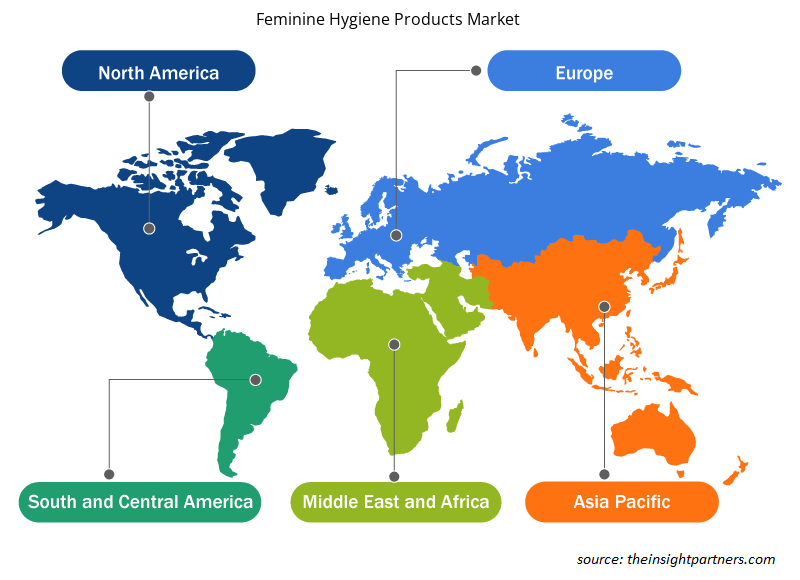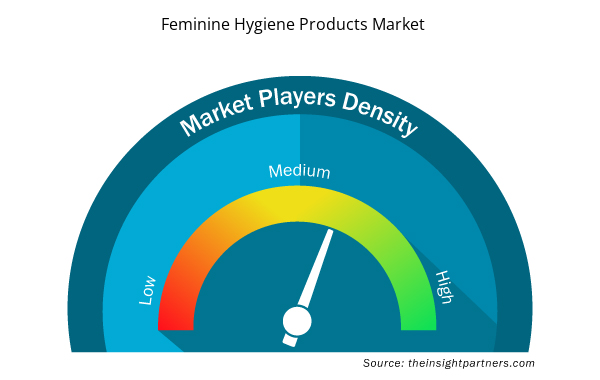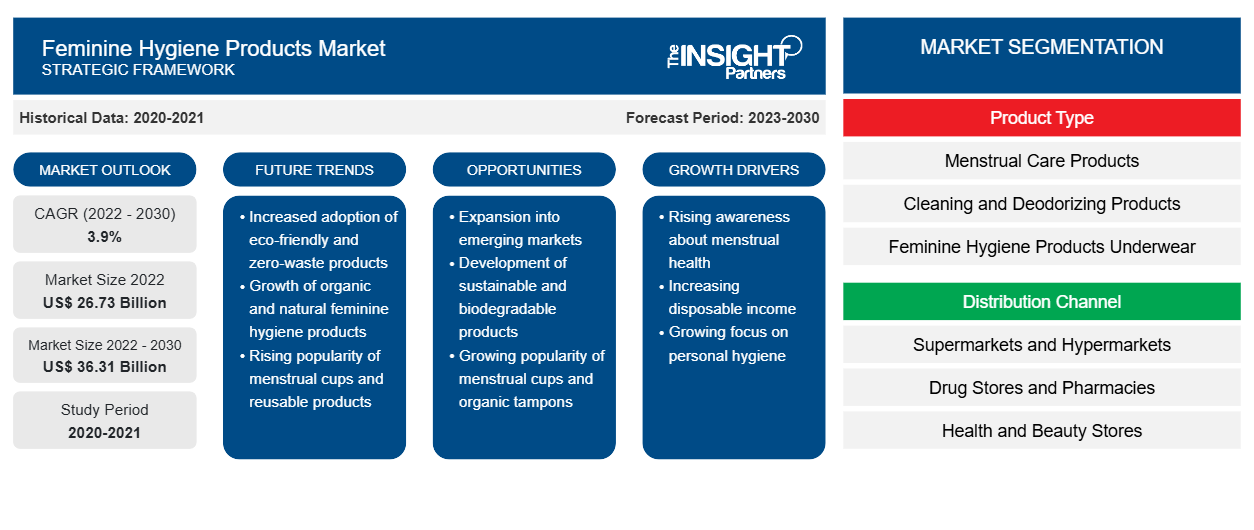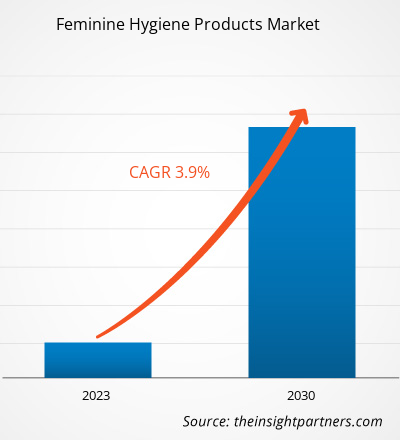[研究报告] 2022 年女性卫生用品市场价值为 267.3333 亿美元,预计到 2030 年将达到 363.0529 亿美元;预计 2022 年至 2030 年的复合年增长率为 3.9%。
市场洞察和分析师观点:
欧洲女性卫生用品市场主要受到个人卫生意识增强和管理机构在女性卫生方面举措增多的推动。此外,由于各种政府举措和社交媒体活动,女性的个人卫生意识也在增强。这些举措和活动有助于更好地理解和接受女性卫生用品。因此,个人卫生意识的提高推动了女性卫生用品市场的增长。北美、欧洲和亚太地区是 Edgewell Personal Care Co、Kimberly-Clark Corp、Lune Group Oy Ltd、Me Luna Gmbh、Mooncup Ltd、Ontex BV、Essity Ab、Wuka Ltd、Cotton High Tech SL 和宝洁公司的中心,这些公司对女性卫生用品的需求很高。因此,这些公司的存在推动了全球女性卫生用品市场的增长。
增长动力和挑战:
主要市场参与者的战略举措一直在推动全球女性卫生用品市场的增长。制造商正在大力投资研发项目、合作伙伴关系、扩张计划和合作,以推出创新产品来吸引大量消费者。例如,2020 年 6 月,Pee Safe 推出了一系列新的私密卫生产品,包括内衣消毒喷雾、可重复使用的卫生巾、氧化可生物降解的一次性袋子和私密卫生粉。主要市场参与者正在采取并购等战略举措来扩大其产品组合和地理分布。例如,2022 年 11 月,Edgewell Personal Care 公司宣布收购 Billie Inc. 此次收购旨在扩大其顶级女性剃须和身体护理品牌的产品组合。
此外,由于人们越来越意识到化学物质的有害影响,并且越来越倾向于使用绿色和清洁的个人护理产品,天然和清洁的脱毛产品在世界范围内越来越受欢迎。这一趋势促使制造商根据客户要求开发天然产品。例如,利洁时集团 (Reckitt Benckiser Group Plc) 于 2022 年推出了 Veet Pure 系列脱毛膏,从而重新配制了其产品。该产品系列包括天然黄瓜提取物、芦荟和葡萄籽油。因此,此类产品发布和其他满足日益增长的消费者需求的策略有助于市场增长。
定制此报告以满足您的需求
您可以免费定制任何报告,包括本报告的部分内容、国家级分析、Excel 数据包,以及为初创企业和大学提供优惠和折扣
- 获取此报告的关键市场趋势。这个免费样品将包括数据分析,从市场趋势到估计和预测。
报告细分和范围:
全球女性卫生用品市场根据产品类型、分销渠道和地理位置进行细分。根据产品类型,女性卫生用品市场细分为月经护理产品、清洁和除臭产品以及女性卫生内衣。根据分销渠道,女性卫生用品市场细分为超市和大卖场、药店和药房、保健和美容店、在线零售和其他。根据地理位置,女性卫生用品市场细分为北美(美国、加拿大和墨西哥)、欧洲(德国、法国、意大利、英国、俄罗斯和欧洲其他地区)、亚太地区(澳大利亚、中国、日本、印度、韩国和亚太地区其他地区)、中东和非洲(南非、沙特阿拉伯、阿联酋和中东和非洲其他地区)以及南美洲和中美洲(巴西、阿根廷和南美洲和中美洲其他地区)。
节段分析:
根据产品类型,女性卫生用品市场可分为月经护理产品、清洁和除臭产品以及女性卫生内衣。月经护理产品部分在女性卫生用品市场增长中占有重要份额,预计在预测期内将实现大幅增长。随着全球女性对女性卫生的意识不断提高,月经护理产品(包括卫生巾、经期内裤、护垫、女性湿巾、卫生棉条和月经杯、卫生巾和卫生巾)越来越受欢迎。此外,这些产品的使用量不断增加也鼓励了人们的环境意识。因此,职业女性和其他对环境敏感的人群正在采用舒适且一次性的月经产品。
月经护理产品通常会被丢弃并进入垃圾填埋场,产生大量不可生物降解的废物。因此,它们以微塑料的形式存在于环境中,对水生和陆地生态系统构成重大威胁。由于人们越来越意识到这一问题,许多人开始改用可重复使用的月经产品,例如月经杯和月经盘以及由布制成的可重复使用的卫生巾。根据 BBC 网站上发表的一篇文章和 Google 趋势搜索词指数,可重复使用的经期产品的搜索量每年都在激增。
区域分析:
根据地理位置,女性卫生用品市场分为五个主要区域:北美、欧洲、亚太、南美和中美以及中东和非洲。全球女性卫生用品市场以北美为主,2022 年达到约 50 亿美元。欧洲是第二大贡献者,占全球市场的 20% 以上。预计亚太地区在预测期内的复合年增长率将超过 5%。北美女性卫生用品市场分为美国、加拿大和墨西哥。北美女性卫生用品市场的增长归因于女性生活水平的提高、卫生习惯的改善和收入水平的提高。该行业见证了女性卫生用品的不断创新,公司推出了新的和改进的产品来满足客户的不同需求和偏好。此外,人们对塑料人口增加和全球变暖等环境问题的日益关注,鼓励女性选择可持续和环保的产品。在北美,每年约有 200 亿个卫生巾、卫生棉条和涂抹器被送往垃圾填埋场。月经杯和布垫等产品因其成本效益高和对环境影响小而广受欢迎。对可持续和环保女性卫生用品的需求激增,导致了产品创新和产品在市场上的推出。例如,2022 年 12 月,Trace Femcare 宣布推出气候有益棉和再生大麻纤维卫生棉条。这些产品解决了塑料人口不断增加和非一次性卫生棉条造成的全球变暖问题。因此,所有上述因素都会影响整个北美女性卫生用品市场的增长。
行业发展和未来机遇:
以下列出了女性卫生用品市场主要参与者采取的各种举措:
- 2021年11月,Ontex BV在中国推出其品牌NAT,推出的产品包括卫生棉条、毛巾、护垫和月经裤。
- 2021年5月,金佰利旗下品牌Poise宣布与Whitney Port合作,推出二合一护垫和卫生巾。
女性卫生用品市场区域洞察
Insight Partners 的分析师已详尽解释了预测期内影响女性卫生用品市场的区域趋势和因素。本节还讨论了北美、欧洲、亚太地区、中东和非洲以及南美和中美洲的女性卫生用品市场细分和地理位置。

- 获取女性卫生用品市场的区域具体数据
女性卫生用品市场报告范围
| 报告属性 | 细节 |
|---|---|
| 2022 年市场规模 | 267.3亿美元 |
| 2030 年的市场规模 | 363.1亿美元 |
| 全球复合年增长率(2022 - 2030 年) | 3.9% |
| 史料 | 2020-2021 |
| 预测期 | 2023-2030 |
| 涵盖的领域 | 按产品类型
|
| 覆盖地区和国家 | 北美
|
| 市场领导者和主要公司简介 |
|
市场参与者密度:了解其对商业动态的影响
由于消费者偏好的不断变化、技术进步以及对产品优势的认识不断提高等因素,最终用户需求不断增加,推动了女性卫生用品市场快速增长。随着需求的增加,企业正在扩大其产品范围,进行创新以满足消费者需求,并利用新兴趋势,从而进一步推动市场增长。
市场参与者密度是指在特定市场或行业内运营的企业或公司的分布情况。它表明相对于给定市场空间的规模或总市场价值,有多少竞争对手(市场参与者)存在于该市场空间中。
在女性卫生用品市场运营的主要公司有:
- Edgewell 个人护理公司
- 金佰利公司
- 鲁内集团有限公司
- Me Luna 有限公司
- 月亮杯有限公司
免责声明:上面列出的公司没有按照任何特定顺序排列。

- 了解女性卫生用品市场顶级关键参与者概况
COVID-19 影响:
在新冠疫情爆发之前,女性识字率的提高和经期卫生意识的增强是推动女性卫生用品市场的主要因素。然而,消费品行业在 2020 年第一季度受到了疫情的不利影响。新冠疫情还导致 2020 年头几个月出现经济衰退,给低收入和中等收入消费者带来了财务困难。因此,人们只购买基本必需品(如杂货和关键医疗产品),从而降低了女性卫生用品的销量。
2020 年封锁最初几个月后,各国政府放松了限制措施,许多企业得以恢复。新冠疫苗的推出进一步缓解了令人不安的疫情形势,导致商业活动增加。制造部门的恢复运营对女性卫生用品市场产生了积极影响,并导致女性卫生用品生产的恢复。制造商被允许满负荷运营,从而克服了供需缺口。
竞争格局和重点公司:
全球女性卫生用品市场的一些知名企业包括 Edgewell Personal Care Co、Kimberly-Clark Corp、Lune Group Oy Ltd、Me Luna Gmbh、Mooncup Ltd、Ontex Bv、Essity Ab、Wuka Ltd、Cotton High Tech SL 和宝洁公司等。这些企业提供具有创新功能的尖端女性卫生产品,为消费者带来卓越的体验。
- 历史分析(2 年)、基准年、预测(7 年)及复合年增长率
- PEST 和 SWOT 分析
- 市场规模价值/数量 - 全球、区域、国家
- 行业和竞争格局
- Excel 数据集



Report Coverage
Revenue forecast, Company Analysis, Industry landscape, Growth factors, and Trends

Segment Covered
This text is related
to segments covered.

Regional Scope
North America, Europe, Asia Pacific, Middle East & Africa, South & Central America

Country Scope
This text is related
to country scope.
常见问题
Based on products type, menstrual care products segment mainly has the largest revenue share. Menstrual care products include sanitary pads/napkins, tampons, menstrual cups, reusable cloth pads, liners, and menstrual discs. Sanitary pads and tampons are among the most widely used products by females during menstruation. They are made of materials such as cellulosic fibers; synthetic polymers such as polyester, polyethylene, and polypropylene; cotton; and superabsorbent polymers. Products made from superabsorbent polymers absorb low to heavy period flow and allow women to perform their daily chores and other physically rigorous activities, such as playing and traveling, without the stress of leakage and stains.
Initiatives by governments and organizations to provide opportunities in the coming years for the feminine hygiene products. The increasing prices of feminine hygiene products owing to higher taxes prevent consumers from buying them. Thus, they search for alternatives, which can hamper their health. However, with increasing awareness about feminine hygiene, various governments of globally are taking various initiatives, such as reducing taxes on feminine hygiene products and distributing them free of cost. For instance, in Germany, the tax rate on sanitary items was cut from 19% to 7% as of 1 January 2020. Ireland levies no value-added tax on tampons, panty liners, and sanitary towels. Ireland is the only EU country with a zero-tax rate on sanitary goods. Thus, reducing taxes on feminine hygiene products accelerates their demand across the region.
Asia Pacific accounted for the largest share of the global feminine hygiene products market. In Europe, the rapidly changing lifestyles of consumers are making them opt for convenient food solutions and ready-to-eat products such as frozen food, feminine hygiene products, biscuits, cookies, etc. The demand for feminine hygiene products is significantly increasing across the region owing to the established status of bakery products as a staple food in many European countries such as Germany, Russia, France, Italy, and the UK, making Europe one of the major markets of feminine hygiene products. Also, the growing health consciousness among Europeans is boosting the demand for feminine hygiene products containing fibers, vitamins and minerals, whole grains, vegetables, and gluten-free bakery products such as gluten-free functional and gluten-free artisanal feminine hygiene products.
Rising awareness of menstrual hygiene are driving the feminine hygiene products market. In recent times, the women population in globally has become more aware of menstrual hygiene, particularly among the working class. Since 2012, several public health organizations have started focusing on menstruation hygiene management (MHM). Grassroots workers, social entrepreneurs, and United Nations agencies are also contributing to this noble cause. For example, in May 2013, WASH United conducted a 28-day social media campaign called "May #MENSTRAVAGANZA" on Twitter to generate awareness about menstruation and MHM. In January 2021, Raigarh district in Chhattisgarh, India, announced the launch of ‘Pavna,’ a unique community-based menstrual hygiene program.
The major players operating in the global feminine hygiene products market are Edgewell Personal Care Co, Kimberly-Clark Corp, Lune Group Oy Ltd, Me Luna GmbH, Mooncup Ltd, Ontex BV, Essity AB, Wuka Ltd, Cotton High Tech SL, The Procter & Gamble Co.
Based on the distribution channel, online retail segment is projected to grow at the fastest CAGR over the forecast period. E-commerce platforms are preferred by consumers owing to the convenience of shopping various products from remote locations, availability of a wide range of products of different brands, exclusive discounts and offers on these sites, and home delivery services (free or paid) offered by these platforms. Additionally, online platforms provide product descriptions, user reviews, and ratings, which help consumers choose the right product. Innovative feminine hygiene products such as menstrual cups, reusable period and incontinence underwear, menstrual discs, and tampon applicators are widely available across e-commerce channels.
Trends and growth analysis reports related to Consumer Goods : READ MORE..
The List of Companies - Feminine Hygiene Products Market
- Edgewell Personal Care Co.
- Kimberly-Clark Corp
- Lune Group Oy Ltd
- Me Luna GmbH
- Mooncup Ltd
- Ontex BV
- Essity AB
- Wuka Ltd
- Cotton High Tech SL
- The Procter & Gamble Co
The Insight Partners performs research in 4 major stages: Data Collection & Secondary Research, Primary Research, Data Analysis and Data Triangulation & Final Review.
- Data Collection and Secondary Research:
As a market research and consulting firm operating from a decade, we have published and advised several client across the globe. First step for any study will start with an assessment of currently available data and insights from existing reports. Further, historical and current market information is collected from Investor Presentations, Annual Reports, SEC Filings, etc., and other information related to company’s performance and market positioning are gathered from Paid Databases (Factiva, Hoovers, and Reuters) and various other publications available in public domain.
Several associations trade associates, technical forums, institutes, societies and organization are accessed to gain technical as well as market related insights through their publications such as research papers, blogs and press releases related to the studies are referred to get cues about the market. Further, white papers, journals, magazines, and other news articles published in last 3 years are scrutinized and analyzed to understand the current market trends.
- Primary Research:
The primarily interview analysis comprise of data obtained from industry participants interview and answers to survey questions gathered by in-house primary team.
For primary research, interviews are conducted with industry experts/CEOs/Marketing Managers/VPs/Subject Matter Experts from both demand and supply side to get a 360-degree view of the market. The primary team conducts several interviews based on the complexity of the markets to understand the various market trends and dynamics which makes research more credible and precise.
A typical research interview fulfils the following functions:
- Provides first-hand information on the market size, market trends, growth trends, competitive landscape, and outlook
- Validates and strengthens in-house secondary research findings
- Develops the analysis team’s expertise and market understanding
Primary research involves email interactions and telephone interviews for each market, category, segment, and sub-segment across geographies. The participants who typically take part in such a process include, but are not limited to:
- Industry participants: VPs, business development managers, market intelligence managers and national sales managers
- Outside experts: Valuation experts, research analysts and key opinion leaders specializing in the electronics and semiconductor industry.
Below is the breakup of our primary respondents by company, designation, and region:

Once we receive the confirmation from primary research sources or primary respondents, we finalize the base year market estimation and forecast the data as per the macroeconomic and microeconomic factors assessed during data collection.
- Data Analysis:
Once data is validated through both secondary as well as primary respondents, we finalize the market estimations by hypothesis formulation and factor analysis at regional and country level.
- Macro-Economic Factor Analysis:
We analyse macroeconomic indicators such the gross domestic product (GDP), increase in the demand for goods and services across industries, technological advancement, regional economic growth, governmental policies, the influence of COVID-19, PEST analysis, and other aspects. This analysis aids in setting benchmarks for various nations/regions and approximating market splits. Additionally, the general trend of the aforementioned components aid in determining the market's development possibilities.
- Country Level Data:
Various factors that are especially aligned to the country are taken into account to determine the market size for a certain area and country, including the presence of vendors, such as headquarters and offices, the country's GDP, demand patterns, and industry growth. To comprehend the market dynamics for the nation, a number of growth variables, inhibitors, application areas, and current market trends are researched. The aforementioned elements aid in determining the country's overall market's growth potential.
- Company Profile:
The “Table of Contents” is formulated by listing and analyzing more than 25 - 30 companies operating in the market ecosystem across geographies. However, we profile only 10 companies as a standard practice in our syndicate reports. These 10 companies comprise leading, emerging, and regional players. Nonetheless, our analysis is not restricted to the 10 listed companies, we also analyze other companies present in the market to develop a holistic view and understand the prevailing trends. The “Company Profiles” section in the report covers key facts, business description, products & services, financial information, SWOT analysis, and key developments. The financial information presented is extracted from the annual reports and official documents of the publicly listed companies. Upon collecting the information for the sections of respective companies, we verify them via various primary sources and then compile the data in respective company profiles. The company level information helps us in deriving the base number as well as in forecasting the market size.
- Developing Base Number:
Aggregation of sales statistics (2020-2022) and macro-economic factor, and other secondary and primary research insights are utilized to arrive at base number and related market shares for 2022. The data gaps are identified in this step and relevant market data is analyzed, collected from paid primary interviews or databases. On finalizing the base year market size, forecasts are developed on the basis of macro-economic, industry and market growth factors and company level analysis.
- Data Triangulation and Final Review:
The market findings and base year market size calculations are validated from supply as well as demand side. Demand side validations are based on macro-economic factor analysis and benchmarks for respective regions and countries. In case of supply side validations, revenues of major companies are estimated (in case not available) based on industry benchmark, approximate number of employees, product portfolio, and primary interviews revenues are gathered. Further revenue from target product/service segment is assessed to avoid overshooting of market statistics. In case of heavy deviations between supply and demand side values, all thes steps are repeated to achieve synchronization.
We follow an iterative model, wherein we share our research findings with Subject Matter Experts (SME’s) and Key Opinion Leaders (KOLs) until consensus view of the market is not formulated – this model negates any drastic deviation in the opinions of experts. Only validated and universally acceptable research findings are quoted in our reports.
We have important check points that we use to validate our research findings – which we call – data triangulation, where we validate the information, we generate from secondary sources with primary interviews and then we re-validate with our internal data bases and Subject matter experts. This comprehensive model enables us to deliver high quality, reliable data in shortest possible time.


 获取此报告的免费样本
获取此报告的免费样本